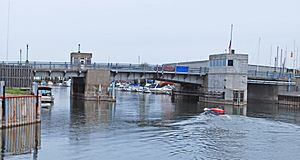Cheboygan Bascule Bridge facts for kids
Quick facts for kids Cheboygan Bascule Bridge |
|
|---|---|

Looking to the west at the bridge at dusk
|
|
| Coordinates | 45°38′45″N 84°28′22″W / 45.6459°N 84.4728°W |
| Carries | |
| Crosses | Cheboygan River |
| Locale | Cheboygan, Michigan |
| Owner | MDOT |
| Maintained by | MDOT |
| ID number | 1501 |
| Characteristics | |
| Design | Double-leaf bascule |
| Total length | 155 ft (47 m) |
| Width | 51.8 ft (15.8 m) |
| Longest span | 70 ft (21 m) |
| Number of spans | 3 |
| History | |
| Construction begin | May 1940 |
| Construction cost | $206,000 |
| Opened | December 1940 |
| Inaugurated | December 7, 1904 |
| NRHP reference No. | 99001509 |
| Added to NRHP | December 9, 1999 |
The Cheboygan Bascule Bridge, also known as the State Street Bridge, is a special kind of bridge in Cheboygan, Michigan. It carries U.S. Highway 23 (State Street) over the Cheboygan River. This bridge was built in 1940. It was the last bridge of its kind built in Michigan before World War II ended. It replaced an older bridge from 1877. The Cheboygan Bascule Bridge is important enough to be listed on the National Register of Historic Places.
A Look Back: The Bridge's Story
Before this bridge, an old iron swing bridge stood here. It was built in 1877. By 1940, it was old and shaky. It was also not safe for all the cars using it. The old bridge would vibrate and bounce.
The new bridge was designed in early 1940. A company called W. J. Storen Company won the contract to build it. Construction started in May 1940. The bridge was finished in December 1940. It cost about $206,000.
The bridge was officially opened on December 7, 1940. This was the last bascule bridge built in Michigan before World War II ended. Other similar bridges were planned but had to wait until after the war.
Why Is This Bridge Special?
The Cheboygan Bascule Bridge was added to the National Register of Historic Places on December 9, 1999. It was chosen because it is a well-preserved example of bascule bridges from that time.
In 2003, the Michigan Department of Transportation (MDOT) planned to fix up the bridge. This work cost $2.1 million. It helped keep the bridge safe and looking good. The project started in January 2004 and finished in June.
During the repairs, the road and sidewalks were replaced. The bridge's moving parts were also balanced. The old railings were replaced with new ones that looked like the originals. New lights were also added to match the downtown area. This work was done in winter to avoid bothering boats.
How the Bridge Works and Looks
The Cheboygan Bascule Bridge is a type of bridge called a bascule bridge. This means parts of it can lift up to let boats pass underneath. It has three main sections. The middle section, which lifts, is 70 feet (21 meters) long. The two side sections are 42 feet (13 meters) long each.
The road surface on the sides is asphalt and concrete. The middle part, which lifts, is made of steel mesh. The road is 40 feet (12 meters) wide. There are also sidewalks on each side, 5 feet (1.5 meters) wide. These sidewalks have metal guard rails for safety.
Important Features
On one side of the bridge, there is a small building. This is the bridge tender's house. Someone works here to open and close the bridge. When the bridge is open, boats have a 60-foot (18-meter) wide path to go through.
The bridge has special safety features. There are six lights along its length to light it up at night. There are also traffic gates and traffic lights. These warn cars when the bridge is about to open for boats.
Bridge Opening Times
The bridge opens at certain times to let boats pass. This is called the "draw schedule."
Summer Schedule (May 16 to September 15)
- From 6 a.m. to 6 p.m., the bridge opens every 15 minutes and 45 minutes past the hour.
- From 6 p.m. to 6 a.m., it opens when a boat signals.
Spring and Fall Schedule (April 1 to May 15 and September 16 to December 14)
- The bridge opens when a boat signals.
Winter Schedule (December 15 to March 31)
- During these months, the bridge does not open unless a boat gives 12 hours' notice. This is because there are very few boats on the river in winter.
Changes to the Schedule
The opening schedule was changed in June 2001. Before that, boats needed 24 hours' notice in winter. MDOT wanted to change it to 12 hours' notice. This helps save money because fewer people are needed to open the bridge in winter.
Sometimes, opening the bridge causes traffic jams. Cars can back up for five blocks in both directions. This happens because the bridge can open four times an hour, for up to ten minutes each time.


